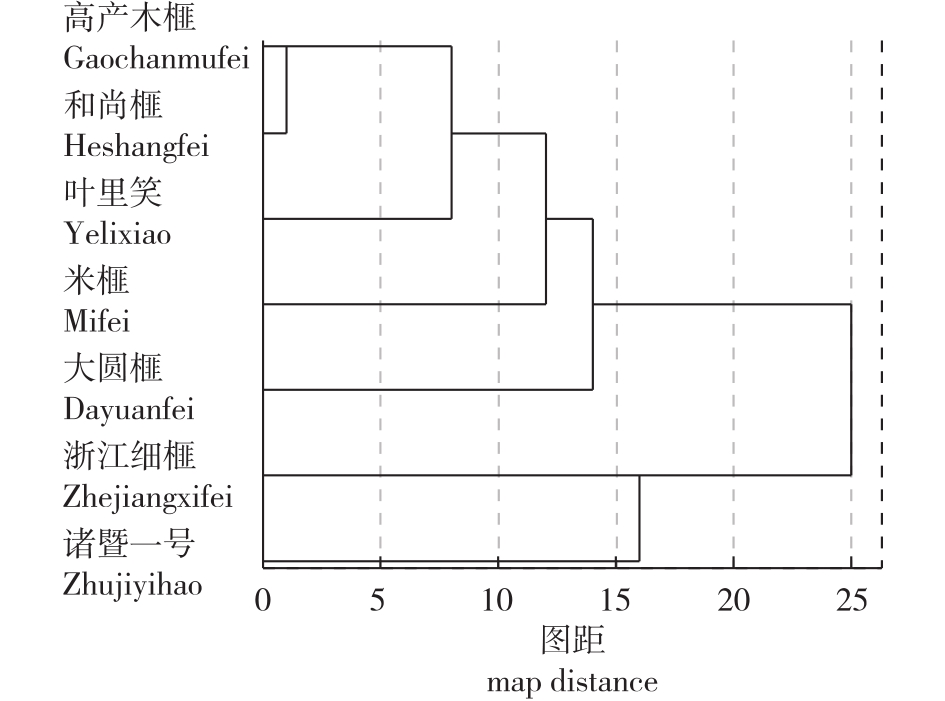 PDF(1523 KB)
PDF(1523 KB)


Studies on the phenotypic traits and quality characteristics of seven superior tree nuts of Torreya grandis ‘Merrillii’
TAO Tao, LIU Yaohui, XUE Zhongjun, GAO Yue, YUAN Luhong, ZHENG Fen, WU Wei, HUANG Jieying
Journal of Nanjing Forestry University (Natural Sciences Edition) ›› 2024, Vol. 48 ›› Issue (2) : 37-44.
 PDF(1523 KB)
PDF(1523 KB)
 PDF(1523 KB)
PDF(1523 KB)
Studies on the phenotypic traits and quality characteristics of seven superior tree nuts of Torreya grandis ‘Merrillii’
【Objective】 This study investigated seven nuts of Torreya grandis‘Merrillii’ to compare and analyze the primary physical properties and content of the main components, understand the quality of T. grandis in Yi County, and provide a theoretical basis for the selection, development, and utilization of improved varieties of T. grandis ‘Merrillii’【Method】 Seven T. grandis were selected ‘Merrillii’ germplasms from Yi County, southern Anhui Province; measured their phenotypic characteristics, mineral elements, nutrient composition, fatty acid composition, and 29 additional physical and chemical properties; and carried out correlation and cluster analyses on the measured data. 【Result】 The phenotypic characteristics and internal quality indices of T. grandis ‘Merrillii’ differed significantly (P < 0.05). The crude protein content ranged from 6.67% to 14.69%. The crude fat content varied from 36.20% to 55.51%, among which the highest average content of polyunsaturated fatty acids was linoleic acid at 47.81%, followed by chrysotile acid at 12.20%. The total potassium (TK) content varied from 0.77% to 1.39%, and there was a significant difference between different superior plants (P < 0.05). 【Conclusion】 According to the comprehensive analysis, the crude protein content of the oblong-shaped Zhujiyihao and Zhejiangxifei was higher than that of T. grandis ‘Merrillii’ types with a round appearance, while the oil acid value of the oblong T. grandis ‘Merrillii’ kernel was lower, and the oil quality was better. Acid value, nuclear shape index, and oleic acid content can be used as the optimum indexes for screening superior plants of T. grandis ‘Merrillii’.

Torreya grandis ‘Merrillii’ / superior strain / phenotypic traits / quality / optimization index
| [1] |
黎章矩, 程晓建, 戴文圣, 等. 香榧品种起源考证[J]. 浙江林学院学报, 2005(4): 443-448.
|
| [2] |
|
| [3] |
王向阳, 修丽丽. 香榧的营养和功能成分综述[J]. 食品研究与开发, 2005, 26(2): 20-22.
|
| [4] |
|
| [5] |
吴剑权, 戴丽玲. 黟县香榧产业现状及发展建议[J]. 现代农业科技, 2021(2): 55-57.
|
| [6] |
程晓建, 黎章矩, 戴文圣, 等. 榧树种质资源调查与评价[J]. 果树学报, 2009, 26(5): 654-658.
|
| [7] |
王衍彬, 刘本同, 秦玉川, 等. 不同品种香榧种子油脂肪酸及香味物质组成分析[J]. 中国油脂, 2016, 41(2): 101-105.
|
| [8] |
任少华, 龙成昌, 王陈, 等. 香榧及其优质高产栽培技术探讨[J]. 现代园艺, 2021, 44(19): 72-74.
|
| [9] |
胡绍泉, 求鹏英, 杜轶君, 等. 绍兴市售香榧坚果品质研究[J]. 中国南方果树, 2016, 45(3): 102-106.
|
| [10] |
程诗明, 闵会, 康志雄, 等. 香榧天然群体遗传多样性分析与评价研究[J]. 浙江林业科技, 2014, 34(4): 11-16.
|
| [11] |
武栋. 安徽徽州榧树种群内种子理化性质的分析[D]. 杭州: 浙江农林大学, 2012.
|
| [12] |
|
| [13] |
鲍士旦. 土壤农化分析[M]. 3版. 北京: 中国农业出版社. 2000: 285-287.
|
| [14] |
赵粼, 张星海, 虞培力. 香榧子超临界萃取物的气相色谱-质谱分析[J]. 湖北农业科学, 2013, 52(1): 186-188.
|
| [15] |
严睿文. ICP-AES 法测定黄山香榧中17种元素[J]. 安徽大学学报(自然科学版), 2007, 31(3): 76-78.
|
| [16] |
|
| [17] |
|
| [18] |
|
| [19] |
叶珊, 王为宇, 周敏樱, 等. 不同采收成熟度和堆沤方式对香榧种子堆沤后熟品质的影响[J]. 林业科学, 2017, 53(11): 43-51.
|
| [20] |
李兴飞, 郜海燕, 陈杭君, 等. 香榧坚果生物活性成分与抗氧化研究进展[J]. 食品科学, 2012, 33(7): 341-345.
|
| [21] |
|
| [22] |
唐丽. 矿物质元素与人体健康[J]. 新疆职业大学学报, 2002, 10(4): 94-96.
|
| [23] |
蔡永立, 王希华, 宋永昌. 中国东部亚热带青冈果实形态变异的研究[J]. 生态学报, 1999, (4): 581-586.
|
| [24] |
戴文圣, 黎章矩, 曹福亮, 等. 香榧林地土壤及其种子矿物元素含量分析[J]. 浙江林业科技, 2006, 26(2): 14-18.
|
| [25] |
|
| [26] |
|
| [27] |
|
| [28] |
|
/
| 〈 |
|
〉 |